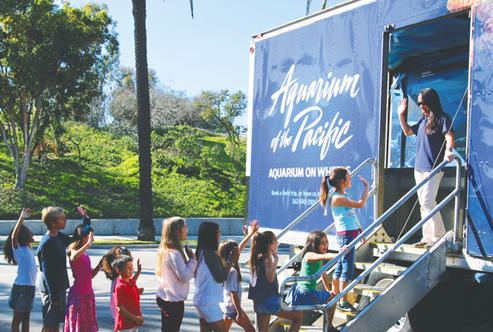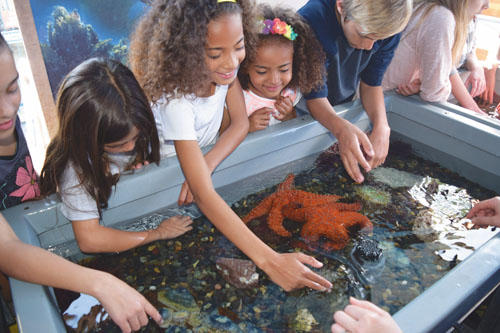In order to achieve its mission to instill a sense of wonder, respect and stewardship for the Pacific Ocean, the Aquarium of the Pacific (AOP) continues to introduce new educational tools and programs to engage its visitors. A primary target for these educational efforts are its young attendees.
“It’s important to engage the breadth of society in becoming stewards for the Pacific Ocean and helping to fulfill the mission and vision of the institution,” David Bader, director of education for the Aquarium, said. “But often youth are more engaged in taking those actions, so they are a prime audience for us to engage with.”

Aquarium of the Pacific educators use the Aquarium on Wheels to bring local tidepool habitats to students throughout Southern California. (Aquarium of the Pacific Photograph)
Every year, about 165,000 students and teachers from the Greater Los Angeles Area visit the Aquarium for field trips. According to Bader, these attendance numbers make the AOP one of the most highly attended aquariums in terms of school visits. Annually, around 30,000 students and teachers visit the Aquarium as part of a scholarship program in which donors cover the cost.
Of the total field trip visits, between 60,000 and 70,000 include onsite classroom programs where students participate in a 45- to 50-minute lecture and activity. Programs range from basic invertebrate classes for K-2 students to squid dissections for high school Advanced Placement Biology students. All scholarship students participate in a classroom program. The AOP offers some pre-K and college programming as well.
Outside of the classroom programs, field trippers enjoy the same experiences as general guests to the Aquarium, which houses more than 50 exhibits showcasing more than 11,000 species native to the Pacific Ocean. However, school field trips are just the tip of the iceberg when it comes to youth and student engagement at the Aquarium.
“We have some of our youth that are doing what is called Science Cafe, where they decide on a topic they want to hear about and we help them to get an expert to speak about it,” Bader said. “They are responsible for inviting their friends to come and listen to a science lecture on a topic they created. It’s been a really successful program. We’re seeing and serving an audience that we don’t typically see and serve – students who are coming out because they are passionate and interested in learning about marine life.”

Students touch marine life as part of Tidepool Animal Exploration aboard the Aquarium on Wheels. (Aquarium of the Pacific Photograph)
For families with children ages 2 to 6, the Aquarium offers parent-and-me classes related to sharks, penguins, octopuses and otters. For “junior biologists” (ages 7 to 12), the Aquarium offers Kids Adventures classes on birds and reptiles, fish, marine mammals, invertebrates, sharks and conservation. In addition, various summer and winter camps are available for youth ages 3 to 15. The Aquarium even has a partnership with local Cub Scout and Girl Scout groups that allows troops to earn badges. Birthday parties, tours, animal encounters and overnight stays are also available.
Teens ages 13 to 17 may sign up to job shadow an Aquarium mammologist, veterinarian, marine biologist, or penguin and lorikeet biologist. For high school students, the Student Eco-Ambassador program is available, which includes a travel-abroad experience to Ecuador. The Aquarium’s VolunTEEN program helps high school students achieve required service learning hours for graduation.
“Engaging youth is a great way of ensuring future ocean stewards and people who take action to support ocean conservation,” Bader said. “But we also have to recognize that our audience is not monolithic. We serve everyone from kids who come with their families to adults who come on their own to participate, and we need to be able to engage with all levels to ensure we’re being as impactful as we possibly can.”
